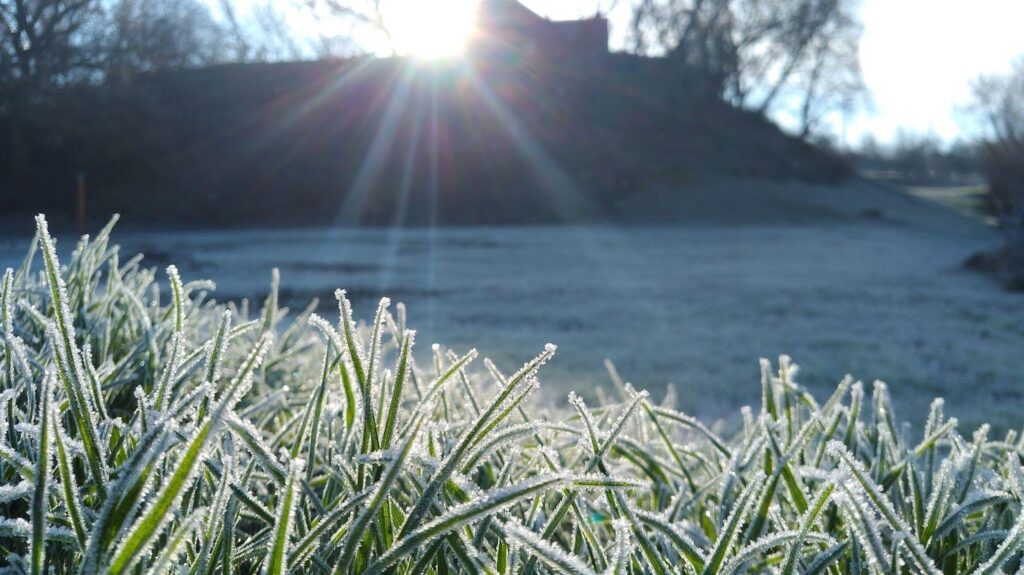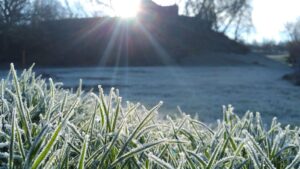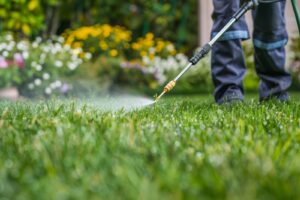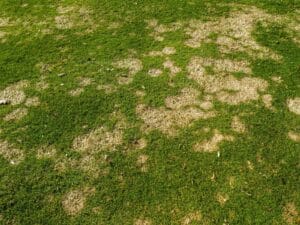Winter might feel like a time to ignore your yard, but proper winter lawn care is essential for keeping your lawn healthy all year long. The cold months present unique challenges like frost, freezing temperatures, and dormancy, all requiring careful attention.
Knowing how to care for your grass before and during winter protects it from damage and prepares it for a lush comeback when spring arrives. Here’s a thorough winter lawn care checklist to help keep your yard in top shape, even when frost becomes a regular visitor.
Mow strategically before winter
As winter approaches, gradually lower the cutting height of your mower in the final weeks of the growing season. Keep the grass shorter for the last few cuts — around 2 to 2.5 inches. Mowing shorter before winter helps reduce the risk of disease by preventing long grass from matting under snow or frost on your lawn.
However, don’t cut it too short, as scalping the lawn weakens the roots, making the grass more vulnerable to winter damage.
Once temperatures drop below 50°F, the grass will stop growing, and you can put the mower away for the season. Make sure your mower blades are sharp before the last mow for a clean cut, which reduces stress on the grass.
Clear debris and leaves
Frost and lawn care don’t go well together when leaves and debris are left sitting on your grass. Before winter settles in, rake up fallen leaves, twigs, and other debris to prevent them from blocking sunlight and trapping moisture, which encourages mold, fungus, and pests.
Leaving debris on the lawn suffocates the grass and leads to dead patches by spring. After the first frost, clear any remaining leaves to let the lawn breathe throughout the colder months, ensuring a healthy winter lawn and reducing stress caused by frost.
Aerate your lawn
Aerating your lawn before winter keeps it healthy by allowing water, oxygen, and nutrients to penetrate the soil more effectively, promoting stronger root growth. This process ensures that frost and lawn care challenges are easier to manage since aerated soil can breathe and absorb essential elements.
Aeration also prevents soil compaction, which leads to poor drainage and unhealthy grass. The ideal time to aerate is in late fall, before the first hard frost, using a core aerator to remove small plugs of soil and give nutrients direct access to the roots, helping the lawn better withstand freezing temperatures.
Fertilize before the frost
Feeding your lawn in late fall, the first frost provides essential nutrients to help it endure the winter months. A high-potassium fertilizer strengthens the root system, ensuring the grass may withstand freezing temperatures and frost on your lawn.
Opt for a winter-specific fertilizer with low nitrogen content to avoid excessive top growth, which is more vulnerable to frost damage. Apply the fertilizer evenly and water it thoroughly to help it settle into the soil. This preparation equips your lawn to handle frost and other winter lawn care challenges effectively.
Water sparingly, but don’t let it dry out
Although your lawn requires less water during winter, it needs hydration until the ground freezes. Frost causes grass to enter dormancy, but dry roots risk winterkill, where grass dies off due to lack of moisture during the cold months.
Keep an eye on weather patterns and water your lawn during dry spells, especially in mild winters with little snow. However, avoid overwatering since saturated soil combined with freezing temperatures can lead to frost heaving, which damages the roots.
Limit foot traffic on frosty grass
Avoid walking on your lawn when frost is present, as frost makes grass blades brittle and prone to breaking underfoot, which leads to visible dead spots once the frost melts.
To prevent this, set up pathways or barriers to direct foot traffic away from the grass and encourage your family and pets to avoid the lawn, especially in the mornings when frost is heaviest. Protecting your lawn during winter from unnecessary damage helps ensure it remains healthy and vibrant in the spring.
Control pests and weeds
Winter doesn’t mean an end to pests or weeds. Some pests burrow into your lawn during the winter months, causing damage to the grass roots. Similarly, certain weeds can germinate during winter, competing with your lawn for nutrients once spring arrives.
Remove snow piles and prevent ice buildup
While snow itself isn’t harmful to your lawn, snow piles and ice buildup can cause significant damage. Large piles prevent air from reaching the grass, leading to mold growth, while prolonged ice cover suffocates the grass, causing dead patches.
To minimize damage, spread snow piles and clear ice from walkways or driveways before it slides onto the lawn. If snow mold develops after the snow melts, rake the affected areas to help the grass recover more quickly.
Inspect for frost heaving
Frost heaving occurs when freezing and thawing cycles cause the soil to expand and contract, pushing the grass roots upward. This may lead to a weakened root system and an uneven lawn surface. Regularly inspect your lawn for signs of frost heaving, especially after extended periods of freezing temperatures.
Prepare for spring growth
Winter lawn care is an ongoing process that continues even after the snow starts falling, ensuring your grass bounces back strong when temperatures rise. Monitor your lawn throughout winter, and once the frost begins to thaw in early spring, take action by raking up any remaining debris, repairing damaged areas, and watering as soon as the ground is no longer frozen.
Apply a balanced fertilizer to support robust spring growth, and watch for weeds and pests. By following these steps, your lawn will return healthier and greener than ever once winter ends.

A brief recap
Winter lawn care may not involve frequent mowing and watering during warmer months, but it’s equally important for maintaining a healthy, vibrant yard.
From mowing correctly before the frost sets to protecting the grass from damage caused by foot traffic and snow piles, following this winter lawn care checklist ensures your grass survives the cold months and thrives in the spring. With proper attention to frost and lawn care, your yard will remain resilient through winter and ready to shine when the snow melts.
Summit Lawn & Pest Control
At Summit Lawn & Pest Control, we know that timing plays a critical role in successful pest control. We choose the best time of day to apply treatments, ensuring maximum effectiveness.
Cooler temperatures in the early morning and late evening allow treatments to settle without evaporating too quickly, targeting pests like ants at dawn or mosquitoes at dusk. Our customized approach guarantees that pests don’t stand a chance.
Don’t wait for them to invade — contact Summit Lawn and Pest Control today, and we’ll develop a strategy that uses precise timing to stop pests when they’re most vulnerable.







